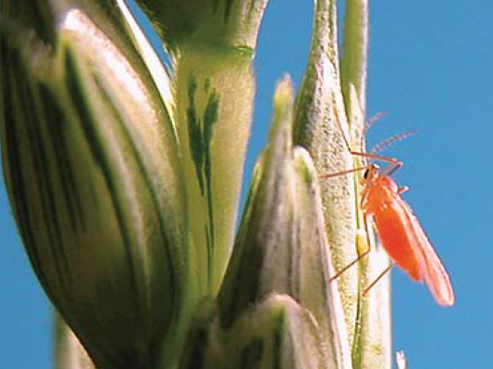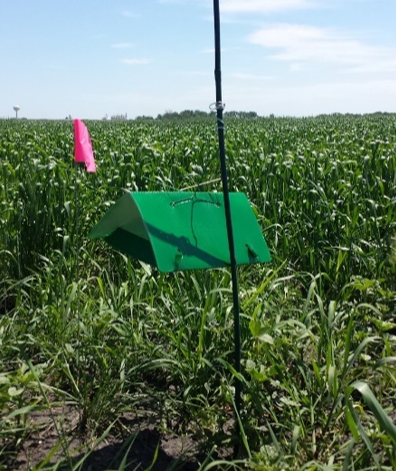Wheat Midge Emergence
This page was adapted from the article, "Wheat Midge Emergence," which appeared in Crop & Pest Report on July 7, 2022.
With the very low populations of wheat midge for two years in a row 2020-2021, producers may not have to scout for adult midges this year unless the field is at high risk with continuous wheat on wheat crop rotation, planting during the 200-600 accumulated wheat midge degree days, and/or favorable moist weather in late June to early July. These three factors can cause rapid increases in the numbers of emerging wheat midge adults.
or planting date susceptibility to wheat midge, producers should use the wheat midge degree-day model by selecting your nearest NDAWN station and entering your wheat planting date. The output indicates the expected growth stage of the wheat and whether the crop is susceptible to midge infestation, as well as the timing of wheat midge emergence for scouting. Producers can access the wheat midge degree-day model on the North Dakota Agricultural Weather Network (NDAWN) website.
Economic Thresholds for Wheat Midge
- Hard red spring wheat = one or more midge observed for every four or five heads
- Durum wheat = one or more midge observed for every seven or eight heads

Due to the late planting of hard red spring wheat in North Dakota this year, much of our HRSW will head after peak wheat midge emergence and be at a lower risk for wheat midge infestation and crop damage.
Field Scouting: Wheat plants are susceptible to wheat midge infestation from heading to early flowering. Wheat midge populations are estimated by counting the number of adults on developing wheat heads during night scouting at five locations in a field. Examine wheat heads at dusk (after 8.30 p.m.) with a flash light when temperatures are above 59⁰F and wind speed is less than 6 mph. The small, orange-colored female wheat midge can be seen fluttering from plant to plant and laying eggs on the wheat heads. Record the number of adult wheat midge and calculate the average number per head for the field. Scouting can be difficult because adults fly at dusk and after dark only when environmental conditions are optimal.
Pheromone traps are commercially available and attract only the adult male wheat midge. Researchers have not found a significant correlation between the number of captured males and the percent of damaged kernels at harvest. Pheromone traps are useful for indicating when to scout and to determine the first, peak and ending flights of male wheat midge.

Pest Management: Use of insecticides is the most common and an effective method for management of economic population densities of wheat midge. Please consult the 2022 North Dakota Field Crop Insect Management Guide E1143 for an updated list of insecticides for wheat midge control. Insecticide application is recommended at dusk because female adults are most active in the top of the crop canopy. However, avoid spraying if there is temperature inversion. Apply in a minimum of 3 to 5 gallons of water per acre for aerial applications and 10 gallons of water per acre for ground applications. Insecticides labeled for wheat midge can be tanked-mixed with fungicides for Fusarium head blight (or scab) control during early flowering. Assuming the economic threshold is reached, the optimal timing of an insecticide is:
- If 70 percent of wheat is at heading to early flowering <30%, treat immediately.
- If 30 percent to 60 percent of wheat heads are at flowering (at least one anther visible), spray immediately, but control likely will be reduced.
If >60 percent of the heads are flowering, treatments are not recommended. Applications at this time are no longer effective because most larvae will be feeding on kernels and are well-protected inside the glumes. Or, plants are no longer attractive to adult wheat midge and further infestation of primary heads and first tillers is unlikely.
In addition, late application will kill the parasitoid wasps, reducing natural biological control.
Producers are wondering what is the best insecticide to use now that Lorsban (chlorpyrifos) is no longer available for wheat midge control. The table (below)) summarizes our insecticide options and their IRAC group (mode of action), trade name, active ingredient, PHI, low and high label rates and estimated cost. Bottom line is that there are not a lot of insecticides options: Group 1B organophosphate – 2 active ingredients, Group 3A pyrethroid - 2 active ingredients and premix of 3A pyrethroid and 28 diamide. If the temperatures are not hot, above >90⁰F, the pyrethroids will effectively kill wheat midge adults and provide the longest residual of 7-10 days. Organophosphates will have a shorter residual of 3-5 days. The premix contains mixture of lambda-cyhalothrin (3A) and chlorantraniliprole (28). Diamides are most commonly recommended for caterpillars (armyworms) and grasshopper control in wheat. We have not tested it for wheat midge control in wheat. I would recommend using the higher labeled rate of the insecticide to improve your control and increase the residual length. We need some newer insecticide products registered for wheat midge control in wheat. This will help prevent the development of insecticide resistance by rotating insecticides between different modes of actions.
| IRAC Group | Example/Trade Name | Active Ingredient(s) | PHI | Low Rate Range (oz/a) | High Rate Range (oz/a) | Low Cost ($/a) | High Cost ($/a) |
|---|---|---|---|---|---|---|---|
| 1B | Diamate 4E | dimethoate | 35 days | 8 | 12 | $4.56 | $4.56 |
| 1B | Fyfanon ULV AG | malathion | 7 days | 8 | 8 | $2.88 | $2.88 |
| 3A | Warrior II | lambda-cyhalothrin | 30 days | 1.28 | 1.92 | $3.79 | $5.68 |
| 3A | Silencer VXN | lambda-cyhalothrin | 30 days | 2.56 | 3.84 | $1.77 | $2.65 |
| 3A, 28 | Besiege | lambda-cyhalothrin + chlorantraniliprole | 30 days | 6 | 10 | $15.12 | $25.20 |
A research efficacy study from Montana State University (courtesy of B. Stougaard) tested Warrior II at a high rate 1.6 fl oz/acre, and Lorsban at 1 pint/acre for wheat midge control. All insecticide treatments had significantly lower number of larvae per head, lower percent of kernels damaged and higher yield than the untreated check under high densities of wheat midge.
*Mention of any insecticides is not an endorsement by the author or NDSU Extension.
